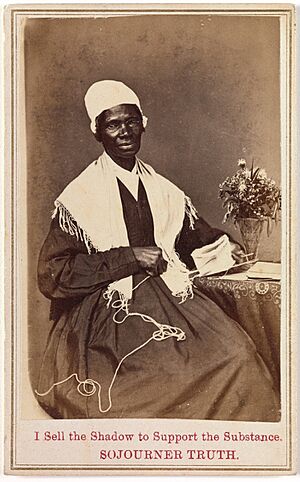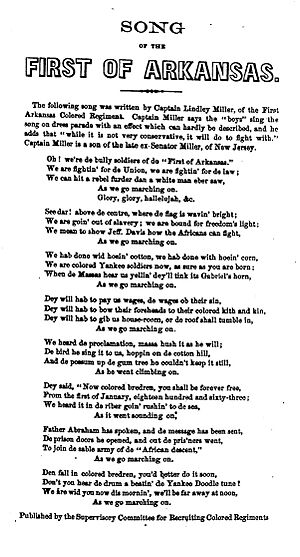Marching Song of the First Arkansas facts for kids
The Marching Song of the First Arkansas Colored Regiment is a special song from the American Civil War. It's one of the few songs from that time that people still sing and record today! This song uses the same tune as "John Brown's Body" and "The Battle Hymn of the Republic".
Many people say the "Marching Song" is a strong statement of black pride. It shows how black soldiers hoped for a better future after the war, known as Reconstruction. It even had a spirit similar to the civil rights movement of the 1960s. Captain Lindley Miller, a white officer in the regiment, wrote the lyrics. There's also a very similar song called "The Valiant Soldiers," which is linked to Sojourner Truth. However, experts now believe Captain Miller was the original writer or at least put the song together.
Contents
History of the Song
Black Soldiers in the Civil War
In July 1862, the U.S. Congress passed laws that allowed formerly enslaved people to join the Union Army. However, President Abraham Lincoln was at first unsure about having black soldiers.
In September 1862, Lincoln announced that on January 1, 1863, all enslaved people in Confederate areas would be free. After this, called the Emancipation Proclamation, Lincoln approved the recruitment of black soldiers.
The First Arkansas Regiment
The First Arkansas Volunteer Infantry Regiment (African Descent) started recruiting former slaves in Helena, Arkansas. This happened after Lincoln's Emancipation Proclamation in January 1863. The regiment officially formed on May 1.
In June, the regiment fought in battles at Mound Plantation in Mississippi and Goodrich's Landing in Louisiana. They stayed there until January 1864. Then, they moved to Haines Bluff near Vicksburg, Mississippi. The Union Army later changed the names of all colored regiments to "United States Colored Troops" (U.S.C.T.). So, on May 11, 1864, the First Arkansas became the "46th Regiment, United States Colored Infantry."
Captain Lindley Miller
Lindley Miller was the son of Jacob W. Miller, who was a U.S. Senator from New Jersey. Lindley became a successful lawyer in New York City. He was also known as a good speaker and poet.
When the war started in April 1861, he joined the 7th Regiment, New York State Militia. In 1862, he married Anne Huntington Tracy. Sadly, Anne died in August 1863 after giving birth, and their baby died a week later. Heartbroken, Lindley Miller decided to become an officer in a colored regiment. He became a captain in the First Arkansas Volunteer Infantry Regiment (African Descent) in November 1863.
How the Song Became Known
Captain Miller first wrote about the "Marching Song" in a letter to his mother on January 20, 1864. He said he wrote a song for his soldiers to the tune of "John Brown's Body," and the whole regiment sang it. He sent a copy to his brother-in-law, Anthony Keasbey.
Keasbey sent the song to a newspaper called the National Anti-Slavery Standard. It was published there on February 27, 1864. Captain Miller was promoted to Major, but he got sick from a fever he caught during his service. He died on June 30, 1864, at age 30.
The "Marching Song of the First Arkansas Colored Regiment" became widely known through a song sheet. This sheet was printed by a group in Philadelphia that helped recruit colored regiments. The song was also included in a collection of Union Army songs published in New York in 1864.
In 1960, Irwin Silber, an editor of Sing Out! magazine, brought the song to a new audience. He published it in his book Songs of the Civil War. Silber believed the song might have been a team effort between Miller and his soldiers. He changed the song to standard English and called it "Marching Song of the First Arkansas (Negro) Regiment."
Song's Melody
The "Marching Song" uses the well-known tune of "John Brown's Body" and "The Battle Hymn of the Republic".
Song Lyrics
Here are the powerful lyrics of the "Marching Song of the First Arkansas Colored Regiment":
1. Oh, we're the bully soldiers of the "First of Arkansas,"
We are fighting for the Union, we are fighting for the law,
We can hit a Rebel further than a white man ever saw,
As we go marching on.
Chorus:
Glory, glory hallelujah.
Glory, glory hallelujah.
Glory, glory hallelujah.
As we go marching on.
2. See, there above the center, where the flag is waving bright,
We are going out of slavery; we're bound for freedom's light;
We mean to show Jeff Davis how the Africans can fight,
As we go marching on! (Chorus)
3. We have done with hoeing cotton, we have done with hoeing corn,
We are colored Yankee soldiers, now, as sure as you are born;
When the masters hear us yelling, they'll think it's Gabriel's horn,
As we go marching on. (Chorus)
4. They will have to pay us wages, the wages of their sin,
They will have to bow their foreheads to their colored kith and kin,
They will have to give us house-room, or the roof shall tumble in!
As we go marching on. (Chorus)
5. We heard the Proclamation, master hush it as he will,
The bird he sing it to us, hoppin' on the cotton hill,
And the possum up the gum tree, he couldn't keep it still,
As he went climbing on. (Chorus)
6. They said, "Now colored brethren, you shall be forever free,
From the first of January, Eighteen hundred sixty-three."
We heard it in the river going rushing to the sea,
As it went sounding on. (Chorus)
7. Father Abraham has spoken and the message has been sent,
The prison doors he opened, and out the pris'ners went,
To join the sable army of "African descent,"
As we go marching on. (Chorus)
8. Then fall in, colored brethren, you'd better do it soon,
Don't you hear the drum a-beating the Yankee Doodle tune?
We are with you now this morning, we'll be far away at noon,
As we go marching on. (Chorus)
Recordings of the Song
After Irwin Silber's book came out, two recordings of the song were made. Pete Seeger and Bill MacAdoo recorded it in 1960 on an album called Songs of the Civil War. Tennessee Ernie Ford recorded it in 1961 on his album Tennessee Ernie Ford Sings Civil War Songs of the North. Both recordings left out the fourth verse, which was seen as a bit controversial.
Other artists have also recorded versions of the "Marching Song." Sparky and Rhonda Rucker included parts of it in a medley on their 1993 album. The bluegrass group ShoreGrass also recorded it in 2005.
The famous group Sweet Honey in the Rock recorded Sojourner Truth's version of the song in 1993. Their founder, Bernice Johnson Reagon, renamed it "Sojourner's Battle Hymn." This version is described as "rousing, brashly defiant, irreverent and joyous." In 2006, a CD called Am I Not a Man and a Brother? Songs of Freedom North and South also featured a performance of "The Valiant Soldiers."
The song's tune is even used in the opera Appomattox by Philip Glass.
Sojourner Truth's Version
Sojourner Truth had her own version of the song, called "The Valiant Soldiers." This version appeared in later editions of her Narrative (her life story) from 1878, 1881, and 1884. It's almost the same as the "Marching Song," but the first line is different: "We are the valiant soldiers who've 'listed for the war." Also, verses six and eight are only in the "Marching Song."

In these later editions of Truth's Narrative, a friend named Francis Titus wrote that Sojourner Truth composed "The Valiant Soldiers." She said Truth sang it in Detroit and Washington.
Sojourner Truth could not read or write. She told her life story to a friend, Olive Gilbert, who wrote it down. Truth sold her Narrative at her public talks. She was a powerful speaker on topics like ending slavery, women's suffrage (the right for women to vote), and temperance (avoiding alcohol). She often included songs in her presentations.
In 1863, Truth visited the First Michigan Colored Infantry in Detroit. Some historians believe she sang "The Valiant Soldiers" during this visit. However, there's no clear proof from that time that she wrote the song before Captain Miller's "Marching Song" was published in 1864.
Truth was first linked to the song in 1878, 14 years after Miller's version came out. Her friend Frances Titus added the song to later editions of Truth's Narrative. While Truth definitely sang the song, there is no evidence that she wrote the lyrics before Lindley Miller.



